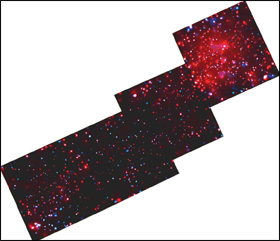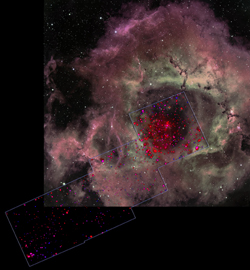September 6, 2001
PSU Press Release
Colorful star-forming regions that have captivated stargazers since the advent of the telescope 400 years ago contain gas thousands of times more energetic than previously recognized, powered by colliding stellar winds. This multimillion-degree gas radiated as X rays is one of the long-sought sources of energy and elements in the Milky Way galaxy's interstellar medium.
A team led by Leisa Townsley, a senior research associate in astronomy and astrophysics at Penn State University, uncovered this wind phenomenon in the Rosette Nebula, a stellar nursery. With the Chandra X-ray Observatory, the team found that the most massive stars in the nebula produce winds that slam into each other, create violent shocks, and infuse the region with 6-million-degree gas.
The findings are presented in Washington, D.C., today at a conference entitled "Two Years of Science with Chandra."
"A ghostly glow of diffuse X-ray emission pervades the Rosette Nebula and perhaps many other similar star-forming regions throughout the Galaxy," said Townsley. "We now have a new view of the engine lighting the beautiful Rosette Nebula and new evidence for how the interstellar medium may be energized."
Townsley and her colleagues created a striking X-ray panorama of the Rosette Molecular Cloud from four images with Chandra's Advanced CCD Imaging Spectrometer. This is a swath of the sky nearly 100 light years across sprayed with hundreds of X-ray-emitting young stars. In one corner of the Rosette Molecular Cloud lies the Rosette Nebula, called an "H II region" because the hydrogen gas there has been stripped of its electrons due to the strong ultraviolet radiation from its young stars. This region, about 5,000 light years away in the constellation Monoceros, the Unicorn, has long been a favorite among amateur astronomers. The wispy, colorful display is visible with small telescopes.
The Chandra survey reveals, for the first time, 6-million-degree gas at the center of the Rosette Nebula, occupying a volume of about 3,000 cubic light years. Fueling the fury are a handful of massive type-O and type-B stars at the core of the nebula, the most massive members of a populous "OB association" that also includes hundreds of lower- mass stars.
"Until this observation, no one really knew where the energy of the powerful OB stellar winds goes," said Eric Feigelson, professor of astronomy and astrophysics at Penn State and a co-investigator in the study. "Theorists have speculated about this for decades, and we now see with Chandra the heat from the winds slamming into the cooler gas."
Earlier X-ray telescopes did not have the resolution to differentiate between point sources and diffuse emission in the Rosette Nebula to the extent that Chandra has. Chandra imaged over 300 individual young stars in the Rosette Nebula, plus hundreds more in the Rosette Molecular Cloud. "We were able to identify the faint, diffuse radiation by subtracting out these point sources and looking at what was left over," explains team member Patrick Broos, a research assistant in astronomy and astrophysics at Penn State.
The diffuse emission is not likely to be from supernova remnants left over from exploded stars because the Rosette Nebula is too young to have produced these, according to You- Hua Chu, of the University of Illinois at Urbana-Champaign. Rather, the diffuse emission must be related to the way the stellar winds from OB associations dissipate their energy. Understanding the detailed processes involved will rely on front-line research done in the laboratory on energy transport in very hot gases, according to Thierry Montmerle, of the Centre d'Etudes de Saclay in France. Chu and Montmerle have joined the research team to help interpret the Chandra results.
The observations were made with Chandra's Advanced CCD Imaging Spectrometer, which was conceived and developed for NASA by Penn State and Massachusetts Institute of Technology under the leadership of Gordon Garmire, the Evan Pugh Professor of Astronomy and Astrophysics at Penn State.




